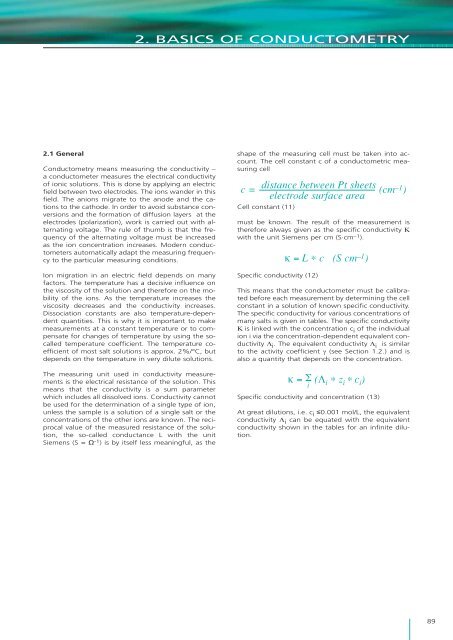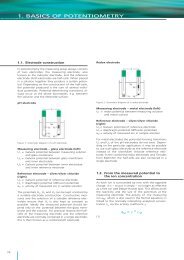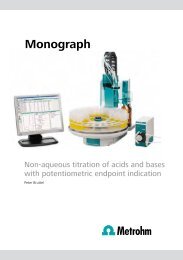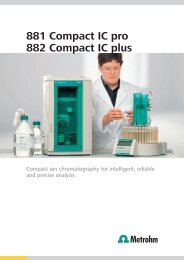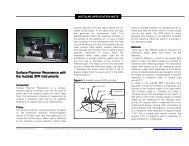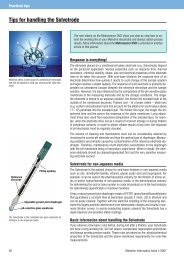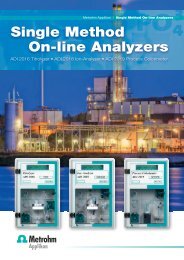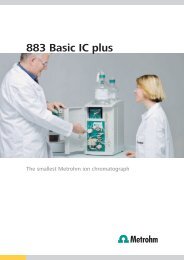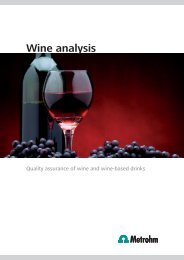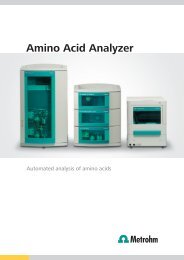What is the theoretical background of conductometry?
What is the theoretical background of conductometry?
What is the theoretical background of conductometry?
Create successful ePaper yourself
Turn your PDF publications into a flip-book with our unique Google optimized e-Paper software.
2. BASICS OF CONDUCTOMETRY2.1 GeneralConductometry means measuring <strong>the</strong> conductivity –a conductometer measures <strong>the</strong> electrical conductivity<strong>of</strong> ionic solutions. Th<strong>is</strong> <strong>is</strong> done by applying an electricfield between two electrodes. The ions wander in th<strong>is</strong>field. The anions migrate to <strong>the</strong> anode and <strong>the</strong> cationsto <strong>the</strong> cathode. In order to avoid substance conversionsand <strong>the</strong> formation <strong>of</strong> diffusion layers at <strong>the</strong>electrodes (polarization), work <strong>is</strong> carried out with alternatingvoltage. The rule <strong>of</strong> thumb <strong>is</strong> that <strong>the</strong> frequency<strong>of</strong> <strong>the</strong> alternating voltage must be increasedas <strong>the</strong> ion concentration increases. Modern conductometersautomatically adapt <strong>the</strong> measuring frequencyto <strong>the</strong> particular measuring conditions.Ion migration in an electric field depends on manyfactors. The temperature has a dec<strong>is</strong>ive influence on<strong>the</strong> v<strong>is</strong>cosity <strong>of</strong> <strong>the</strong> solution and <strong>the</strong>refore on <strong>the</strong> mobility<strong>of</strong> <strong>the</strong> ions. As <strong>the</strong> temperature increases <strong>the</strong>v<strong>is</strong>cosity decreases and <strong>the</strong> conductivity increases.D<strong>is</strong>sociation constants are also temperature-dependentquantities. Th<strong>is</strong> <strong>is</strong> why it <strong>is</strong> important to makemeasurements at a constant temperature or to compensatefor changes <strong>of</strong> temperature by using <strong>the</strong> socalledtemperature coefficient. The temperature coefficient<strong>of</strong> most salt solutions <strong>is</strong> approx. 2%/°C, butdepends on <strong>the</strong> temperature in very dilute solutions.The measuring unit used in conductivity measurements<strong>is</strong> <strong>the</strong> electrical res<strong>is</strong>tance <strong>of</strong> <strong>the</strong> solution. Th<strong>is</strong>means that <strong>the</strong> conductivity <strong>is</strong> a sum parameterwhich includes all d<strong>is</strong>solved ions. Conductivity cannotbe used for <strong>the</strong> determination <strong>of</strong> a single type <strong>of</strong> ion,unless <strong>the</strong> sample <strong>is</strong> a solution <strong>of</strong> a single salt or <strong>the</strong>concentrations <strong>of</strong> <strong>the</strong> o<strong>the</strong>r ions are known. The reciprocalvalue <strong>of</strong> <strong>the</strong> measured res<strong>is</strong>tance <strong>of</strong> <strong>the</strong> solution,<strong>the</strong> so-called conductance L with <strong>the</strong> unitSiemens (S = Ω -1 ) <strong>is</strong> by itself less meaningful, as <strong>the</strong>shape <strong>of</strong> <strong>the</strong> measuring cell must be taken into account.The cell constant c <strong>of</strong> a conductometric measuringcellc = d<strong>is</strong>tance between Pt sheets (cm –1 )electrode surface areaCell constant (11)must be known. The result <strong>of</strong> <strong>the</strong> measurement <strong>is</strong><strong>the</strong>refore always given as <strong>the</strong> specific conductivity Κwith <strong>the</strong> unit Siemens per cm (S·cm –1 ).Specific conductivity (12)κ = L * c (S cm –1 )Th<strong>is</strong> means that <strong>the</strong> conductometer must be calibratedbefore each measurement by determining <strong>the</strong> cellconstant in a solution <strong>of</strong> known specific conductivity.The specific conductivity for various concentrations <strong>of</strong>many salts <strong>is</strong> given in tables. The specific conductivityΚ <strong>is</strong> linked with <strong>the</strong> concentration c i <strong>of</strong> <strong>the</strong> individualion i via <strong>the</strong> concentration-dependent equivalent conductivityΛ i . The equivalent conductivity Λ i <strong>is</strong> similarto <strong>the</strong> activity coefficient γ (see Section 1.2.) and <strong>is</strong>also a quantity that depends on <strong>the</strong> concentration.κ = Σ (Λ i * z i * c i )iSpecific conductivity and concentration (13)At great dilutions, i.e. c i ≤0.001 mol/L, <strong>the</strong> equivalentconductivity Λ i can be equated with <strong>the</strong> equivalentconductivity shown in <strong>the</strong> tables for an infinite dilution.89
2. BASICS OF CONDUCTOMETRYTable 14: Conductivity Κ <strong>of</strong> various substances and solutionsConductorMetallic copperPotassium hydroxidesolution (c = 1 mol/L)KCl solution(c = 0.1 mol/L)Brack<strong>is</strong>h waterAcetic acid(c = 1 mol/L)Drinking waterGraphiteD<strong>is</strong>tilled waterUltrapure waterPure benzeneT (K)273291293273291298273273273273Conductivity caused byElectronic conductionIonic conduction resulting from<strong>the</strong> complete d<strong>is</strong>sociation <strong>of</strong> KOHIonic conduction resulting from<strong>the</strong> complete d<strong>is</strong>sociation <strong>of</strong> KClIonic conduction resulting from<strong>the</strong> d<strong>is</strong>sociation <strong>of</strong> salts and carbonic acidIonic conduction resulting from<strong>the</strong> partial d<strong>is</strong>sociation <strong>of</strong> CH 3 CH 2 COOHIonic conduction resulting from<strong>the</strong> d<strong>is</strong>sociation <strong>of</strong> salts and carbonic acidElectronic conductionIonic conduction resulting from contaminationby salts, d<strong>is</strong>sociation <strong>of</strong> water and carbonic acidIonic conduction resulting fromlow self-d<strong>is</strong>sociationIonic conduction resulting from<strong>the</strong> d<strong>is</strong>sociation <strong>of</strong> traces <strong>of</strong> waterConductivity Κ (μS cm –1 )645’000’000’000184’00011’66020’000...1’000’0001’30010...2’0001’2000.06...100.0560.00000005Conductometry <strong>is</strong> used for direct measurements andin titration. The <strong>the</strong>ory <strong>is</strong> identical for both methods.Whereas in direct measurements it <strong>is</strong> <strong>the</strong> absolutevalue that <strong>is</strong> <strong>of</strong> interest, in titrations it <strong>is</strong> <strong>the</strong> change in<strong>the</strong> measured value. Direct measurement <strong>is</strong> <strong>of</strong>tenused for monitoring surface waters, waterworks, waterdesalination plants and in <strong>the</strong> preparation <strong>of</strong> ultrapurewater, where particular limits must not beexceeded. Conductivity detection <strong>is</strong> mostly used forprecipitation titrations, where <strong>the</strong> equivalent point <strong>is</strong>recognized by <strong>the</strong> conductivity reaching a minimumvalue. The absolute value <strong>is</strong> <strong>of</strong> secondary importance.Selecting <strong>the</strong> right cell constantThe cell constant c <strong>is</strong> defined for conductometricmeasuring cells. A measuring cell with two parallelelectrodes at a d<strong>is</strong>tance <strong>of</strong> 1 cm and each with anarea <strong>of</strong> 1 cm 2 <strong>the</strong>oretically has a cell constantc = l · A -1 = 1 cm -1 . The cell constant <strong>is</strong> never exactlyl · A -1 , as <strong>the</strong> electric field <strong>is</strong> not strictly homogeneous.The rules <strong>of</strong> thumb given in Table 15 are usedfor selecting <strong>the</strong> correct measuring cell:Conductivity measurementsWhereas <strong>the</strong> instruments used for potentiometryhave been standardized (input impedance >10 12 Ω,zero point at pH 7), th<strong>is</strong> <strong>is</strong> not <strong>the</strong> case with conductometers.The influence <strong>of</strong> <strong>the</strong> cable capacity, <strong>the</strong>measuring frequency level, <strong>the</strong> conductivity rangeand <strong>the</strong> adjustable cell constant, <strong>the</strong> method used forconductivity measurements (phase-sensitive, frequency-dependent,bipolar pulse, etc.) vary and dependon <strong>the</strong> type <strong>of</strong> instrument. Th<strong>is</strong> means that <strong>the</strong>instrument must be taken into account for solvingapplication problems. Important parameters are:• Platinizing quality (platinum black) ➝ high seriescapacity C S• Electrode area A ➝ high series capacity C S• Cell constant c• Measuring frequency f• Cable capacity C P• Cable res<strong>is</strong>tance R C• Instrument measuring range (res<strong>is</strong>tance range)Figure 13:Cell constants and recommended conductivity intervals.90
Table 15: Recommended cell constantsInterferences, carec = 0.1 cm -1c = 1 cm -1c = 10 cm -1c = 100 cm -1Conductivity measuring cells with Pt sheetsConductivity cells have a very porous black platinumcoating in order to avoid polarization effects in mediawith a high conductivity. However, <strong>the</strong> properties <strong>of</strong>th<strong>is</strong> coating may change in time (contamination, abrasion<strong>of</strong> <strong>the</strong> platinum coating, etc.); th<strong>is</strong> could alter<strong>the</strong> cell constant. Th<strong>is</strong> <strong>is</strong> why it <strong>is</strong> absolutely necessaryto calibrate <strong>the</strong> conductometric measuring cell beforemaking a measurement in order to avoid measuringerrors. For <strong>the</strong> exact determination <strong>of</strong> cells with a cellconstant <strong>of</strong> 1 cm -1 ) ➝measured value d<strong>is</strong>placedCarryover <strong>of</strong> residual saltswhen changing to solutionswith low conductivity ➝drift to higher valuesAir bubble located betweenelectrode plates ➝ unsteady signalMeasuresHigh measuring frequency, instrument withhigh resolution or cell constant >1 cm -1 ,short cable (low R c )Low measuring frequency, instrument withhigh resolution in upper res<strong>is</strong>tance rangeor cell constant
2. BASICS OF CONDUCTOMETRY2.2. Conductivity measurement in water forpharmaceutical use according to USP andPharm. Europe (EP)There are special requirements for <strong>the</strong> conductivitymeasurement in water for pharmaceutical use («waterfor injections») according to USP 645, EP 2.2.38resp. <strong>the</strong> latest EP -4.8-07/2004:0169. Besides a prec<strong>is</strong>ionconductometer whose temperature compensationcan be d<strong>is</strong>abled, a conductivity measuringcell and a conductivity standard are to be used thatallow to determine <strong>the</strong> cell constant with a maximummeasuring error <strong>of</strong> 2%. To prevent <strong>the</strong> uptake <strong>of</strong> carbondioxide, <strong>the</strong> measurement should be carried underexclusion <strong>of</strong> air and/or in a flow cell. The samplefulfills <strong>the</strong> specification if one <strong>of</strong> <strong>the</strong> following threeconditions <strong>is</strong> met:Stage 1:The sample <strong>is</strong> measured directly without fur<strong>the</strong>r pretreatmentand without temperature compensation. If<strong>the</strong> water fulfills <strong>the</strong> specification indicated in table17, <strong>the</strong> test <strong>is</strong> considered as passed.Stage 2:If <strong>the</strong> conditions are not fulfilled by stage 1, continueas follows: The conductivity <strong>of</strong> at least 100 mL sample<strong>is</strong> measured under strong agitation at 25 °C ±1 °C assoon as <strong>the</strong> drift caused by <strong>the</strong> uptake <strong>of</strong> carbondioxide <strong>is</strong> smaller than 0.1 μS/cm per five minutes. If<strong>the</strong> measured value <strong>is</strong> smaller than 2.1 μS/cm, <strong>the</strong> test<strong>is</strong> considered as passed.Stage 3:However, if <strong>the</strong> sample does not fulfill <strong>the</strong> specification<strong>of</strong> stage 2, a sample <strong>of</strong> exactly 100 mL <strong>is</strong> mixedwith 0.3 mL saturated KCl solution. Then <strong>the</strong> pH value<strong>of</strong> th<strong>is</strong> solution <strong>is</strong> measured exactly to 0.1 pHunits. Only if <strong>the</strong> conductivity fulfills <strong>the</strong> conditionsspecified in table 18 <strong>the</strong> test <strong>is</strong> considered as passed.O<strong>the</strong>rw<strong>is</strong>e <strong>the</strong> water cannot be used for pharmaceuticalpurposes.Table 17: First step <strong>of</strong> <strong>the</strong> conductivity measurement according to USP 645 and EP -4.8-07/2004:0169Temperature Conductivity not Temperature Conductivity notlarger than (μS/cm)larger than (μS/cm)0 0.6 55 2.15 0.8 60 2.210 0.9 65 2.415 1.0 70 2.520 1.1 75 2.725 1.3 80 2.730 1.4 85 2.735 1.5 90 2.740 1.7 95 2.945 1.8 100 3.150 1.9Table 18: pH and conductivity criteria for stage 3pH Conductivity not pH Conductivity notlarger than (μS/cm)larger than (μS/cm)5.0 4.7 6.1 2.45.1 4.1 6.2 2.55.2 3.6 6.3 2.45.3 3.3 6.4 2.35.4 3.0 6.5 2.25.5 2.8 6.6 2.15.6 2.6 6.7 2.65.7 2.5 6.8 3.15.8 2.4 6.9 3.85.9 2.4 7.0 4.66.0 2.492


